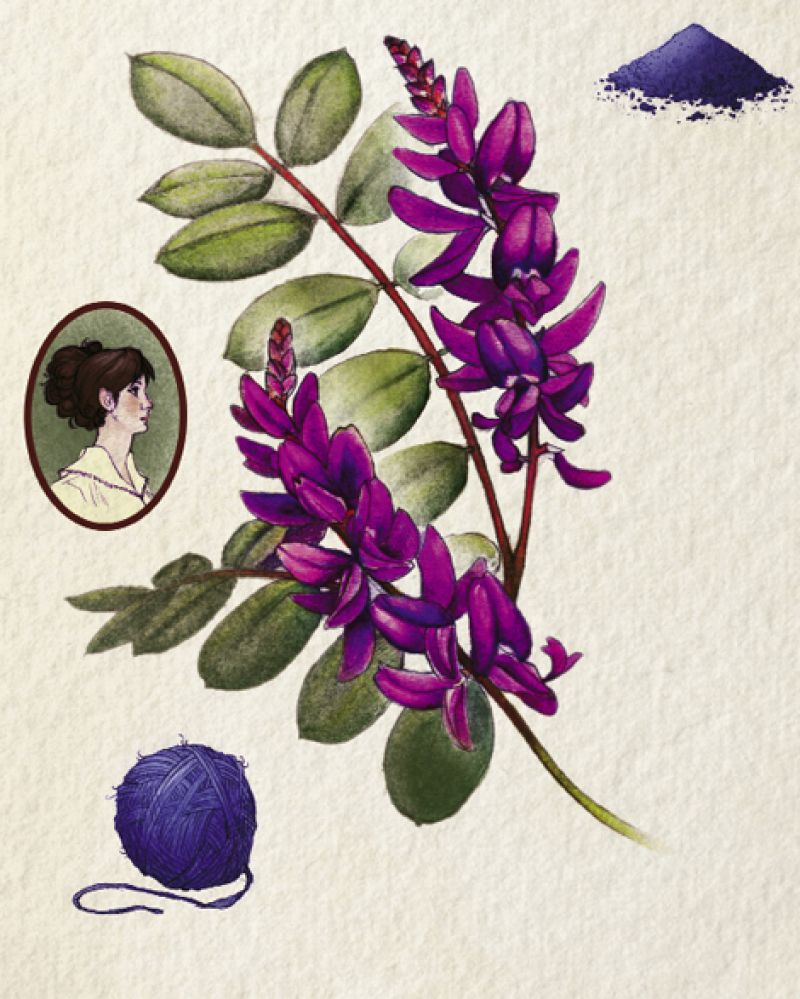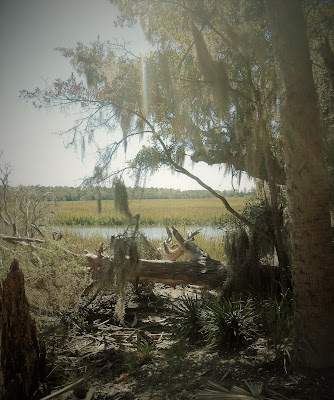

Eliza Pinckney is credited with the development of the lowcountry indigo industry in the mid-1700s. Indigo remained a cash crop, and an important part of the South Carolina economy, into the 19th century. It was one of their primary exports and was used as a blue dye during the colonial period. The existing plantation system worked well, using slave labor to cultivate both indigo and rice.
Indigo is one of the oldest dyes used for printing and textile coloring. Ancient Romans made blue ink from the plant, which they called “indicum,” and the first indigo dye was created as early as 2,000 BC in India. In fact, it is from the word “indigo” that India came to be named. Indigo could be grown on the highlands at the same time rice was grown on the lowlands, giving many plantations a double crop. In 1773, South Carolina sent 1,107,660 pounds of indigo dye to the United Kingdom.
The cycle of planting, processing, and marketing indigo began in March, when the fields were prepared for sowing. Planting began in early April, with a first harvest in July and often a second harvest in August or September. After cutting, the plant was carried to the processing site. The process for creating indigo dye was exacting and could easily fail. Once the plant reached maturity, the stems and leaves were crushed and fermented in a series of three vats—they steeped in the first, then the liquid was piped into the second, where wooden paddles turned until it reached the right color. In a third vat, it solidified to the consistency of mud and was placed in linen bags to drain. Then it went in flat boxes to a curing shed, where it dried into cakes that could be easily exported.
Slaves were responsible for most of South Carolina’s indigo production. Field slaves planted, weeded, and harvested the crop, and skilled “indigo slaves” worked to convert the plant to dye. Slaves who understood the art of processing the dye had greater value, as an entire year’s product depended on the talents of the indigo maker. After the Revolutionary War, indigo sales dropped dramatically, in part because the Continental Congress banned the exportation of goods to England. By 1800, the indigo culture had all but disappeared and was being replaced by the culture of long-staple cotton.
For many thousands of years, humans have used indigo to create a blue dye for a wide variety of textiles. Indigo was grown on hundreds of plantations in eighteenth-century South Carolina, predominantly, but not exclusively, in the Lowcountry or coastal plain. It was almost always grown in conjunction with other crops, such as rice, provisions (corn, beans, etc.), and cotton. As with tobacco in Virginia and sugar cane in the Caribbean, indigo was quite literally a foreign commodity to the early settlers of South Carolina. They did not plant indigo here as an extension of farming traditions back “home.”
It is possible that African slaves transported to early South Carolina might have had some experience with indigo cultivation in their native land. Enslaved people were certainly deeply involved in the production of indigo in early South Carolina, but it seems unlikely that they would have had the freedom to cultivate the crop and manufacture the blue dye for their own use. It is estimated that fifteen slaves were required to plant and tend fifty acres of indigo, and another twenty-five 'skilled' slaves were needed to transform that fifty acres of plants into dye.
It is possible that African slaves transported to early South Carolina might have had some experience with indigo cultivation in their native land. Enslaved people were certainly deeply involved in the production of indigo in early South Carolina, but it seems unlikely that they would have had the freedom to cultivate the crop and manufacture the blue dye for their own use. It is estimated that fifteen slaves were required to plant and tend fifty acres of indigo, and another twenty-five 'skilled' slaves were needed to transform that fifty acres of plants into dye.
Though not constructed until 1814, Fort Sumter plays an important role in lowcountry history. It was built on an artificial island and protects Charleston Harbor from naval invasion. The fort was named for Revolutionary War hero General Thomas Sumter. When the American Civil War began in 1861, the first shots were fired at Fort Sumter. Touring the fort today, you can see a pre-war South Carolina state flag, and the remains of the bombed out walls. It was originally three times as tall as it currently stands.
Today, you can see hints of the old South Carolina tucked in plantation sites and historic stops along the state's scenic byways. Remnants of slave culture remain, too, such as this bottle tree. The folk-art legend of the bottle tree began in the Congo during the ninth century. Blue bottles were hung upside down on trees and huts as talismans to ward off evil spirits. Bottles were also tied to trees near important locations such as meeting places or crossroads to trap any spirits that were travelling.Modern downtown Charleston is a hodgepodge of old and new - with historic, two hundred year old sites butted up against modern construction. Off-the-beaten-path beaches still show glimpses of another time, while the Cooper River Bridge is a testament to the continual progress of the city.
Take an Aerial Tour of Charleston
Our spine read for this unit is The Indigo Girl
Get the entire unit in the World History Bundle!
 Includes ten unit studies (plus a bonus!) covering World History. Each unit addresses a new topic, spanning from Ancient Hawaii to modern-day. There is also a study of archaeological concepts. Each unit has introductory text, which will give the student basic background information about the topic at hand.
Includes ten unit studies (plus a bonus!) covering World History. Each unit addresses a new topic, spanning from Ancient Hawaii to modern-day. There is also a study of archaeological concepts. Each unit has introductory text, which will give the student basic background information about the topic at hand.- There are photographs and illustrations, and we have also included primary documents when available.
- After this text, there are featured videos, which augment the background information and help make the topic more accessible for more visual students.
- You will also find a short list of reading books, including a featured novel that the unit builds upon.
- There are vocabulary words, places, and people to identify.
- Reading comprehension, critical thinking questions, and writing assignments are included.
- We add fun with hands-on activities and extra videos to watch that will bring the era to life.
Product samples: Motel of the Mysteries & Encounter
Includes:- Motel of the Mysteries
- Island Boy
- Encounter
- The Odyssey
- A Loyal Foe
- Indigo Girl
- Gold Rush Girl
- Around the World in 80 Days
- Number the Stars
- To Kill a Mockingbird
- House of the Seven Gables (bonus)

















No comments:
Post a Comment
Note: Only a member of this blog may post a comment.